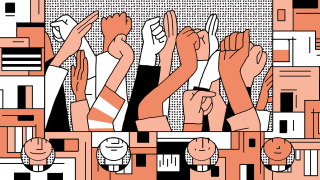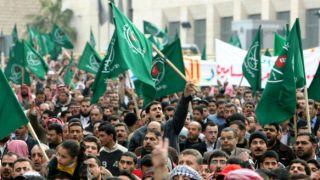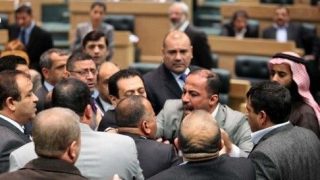Muslims make up 97% of Jordan’s population, which according to statistics amounts to six million people. According to a poll conducted by the Center for Strategic Studies at the University of Jordan in 2011, 90% of Jordanian Muslims describe themselves as “religious” or “relatively religious.”
While 52% of respondents considered religious practices to be “private matters that must be differentiated from social and political life,” 42% of the respondents disagreed with the statement. Far from statistics, religion plays a major role in Jordan’s social and economic structure. The impact of religion varies according to the different types of rival Islamic groups.
The Muslim Brotherhood is a “familial” movement, whose affiliated members in Jordan number about 15,000 people distributed among 35 divisions scattered across all Jordanian governorates. Therefore, the Brotherhood ranks as the largest religious movement in the country. However, the movement’s impact extends beyond the official number of members, as there are more than 100,000 people who benefit socially and economically from the services provided by the group.
This is not to mention the people who are politically aligned with the Brotherhood. The group first emerged in Jordan in 1945, when Abdul Latif Abu Qura, a merchant of Syrian origin, came into contact with the founder of the Egyptian Brotherhood, Hassan al-Banna.
During the group’s foundation period, Palestinians came to the forefront as they occupied the majority of leadership positions and were its top cadres. Palestinians have been increasingly affiliated with the group. This is particularly true given that in 1948 Abu Qura took 100 men to fight with him in Palestine.
In 1953, the Jordanian Brotherhood merged with its Palestinian counterpart. However, the group was still referred to as "the Palestinian movement," since the group in Jordan had few members and was less organized and unable to break through tribal values. Jordanian tribes were less modern and open-minded than the Palestinian community at the time.
After 67 years the Brotherhood emerged with five leaders — including only one of Palestinian origin — and the movement is still seen as a Palestinian group. What reinforces this view is the heavy presence of the Brotherhood in communities inhabited by Jordanians of Palestinian origin, especially in the capital Amman. This is not to mention the Palestinian refugee camps, which are described as the “backyards of the Brotherhood.”
The reality is that the Muslim Brotherhood appeals to all social classes. Both the the very poor and the wealthy are affiliated with the group. However, the impact of the group seems more pronounced among poor communities, given the donations cash and aid that is provided by the Islamic Society Center, the group’s charity wing. What’s more, the Brotherhood requires the sons of families benefiting from its services to attend Brotherhood-affliated institutions to receive a proper “Muslim education,” grooming them to become dutiful Muslims.
According to a cable issued by the United States Embassy in Amman on October 1, 2009 and leaked by WikiLeaks on August 30, 2011, the Islamic Society Center was was established in 1963 and seized by the Jordanian government in 2006. The center sponsors more than 20,000 orphans, operates 55 schools and has more than 3,500 employees. The document, based on statements made by Islamic figures, estimated the center’s assets at more than $1.5 billion.
The Muslim Brotherhood in Jordan has a presence in all state institutions. The group provides members who cannot find jobs in the government opportunities to work in its institutions, where they are given priority in employment. Therefore, it is almost possible to suggest that there are no unemployed Muslim Brotherhood members.
The Muslim Brotherhood in Jordan, as in other countries, emphasizes the importance of internal cohesion. The group tends to strengthen familial relations by arranging dates and marriages among group members, thus becoming more coherent and immune to schisms.
Salafist current: More vocal, less influential
The Salafist Call movement was introduced into Jordanian society during the 1990s, when Sheikh Nasser al-Din al-Albani settled in the capital, Amman. Through him, the current gained momentum and gained many followers and disciples. But there are no exact statistics regarding their numbers, which — according to unofficial estimates — are significantly lower than those of the Muslim Brotherhood.
During the era of Albani — the spiritual father of the movement and its most dominant figure — the Salafist Call focused on "correcting and purifying people’s beliefs" from "heresies." As a result, the Salafist Call clashed directly with the religious culture that prevailed in Jordanian society and fought battles against the Sufi current and the Muslim Brotherhood.
The Salafist current did not develop in a systematic way during the era of Albani, who died in 1999. After his death the movement split into two rival factions: conservative Salafism which upheld the ideas of Albani, and jihadist Salafism, whose main preacher was Abu-Muhammad al-Maqdisi.
Just as the Palestinians were key in the formation of the Muslim Brotherhood, they also played an essential part in the formation of the Salafist movement. However, the Salafist movement quickly got rid of the complexity that accompanied the formation of the Brotherhood, and also avoided the description that it is a movement for Jordanians of Palestinian origin. The movement came to be considered a movement for East Bank Jordanians [Jordanians of Palestinian descent or origin] , especially after the rise of former al-Qaeda leader, the “East Bank Jordanian," Abu Musab al-Zarqawi. Zarqawi had been taught by Abu Muhammad al-Maqdisi and was killed in Iraq in 2006 by US forces.
The Salafist movement in Jordan spans three generations. The first generation of Salafists goes back to the 1980s and consists of the marginalized and the poor. The second generation dates back to the 1990s and began in prisons by repentant criminals, which gave the generation an extremist and aggressive character. After 2001, the third generation started and gathered groups of intellectuals, academics and wealthy people.
With the emergence of jihadist movements and their extremist stance towards the state, Salafists disappeared from public institutions. Followers of these movements refuse to work in government institutions belonging to a state that they describe as “infidel.” Therefore, they either prefer to work in the private sector — which is in line with their ideological logic — or to establish their own projects. Unemployment is clearly common among members of these groups, but the unemployed individuals’ sources of income are not known.
The Salafist movement is represented by a small number of associations such as the Al Kitab wal-Sunnah Association that receives generous support from Saudi Arabia. The association’s work is focused on providing donations to the poor. However, it failed to spread the Salafist message amid disputes among disagreeing Salafist movements. The effectiveness of these organizations is limited by the state's restraints on their activities.
The impact of these Salafist movements on Jordanian society is evident. The uproar resulting from the presence of their followers, who are described as confrontationalists, particularly the jihadists, became a registered trademark of their name. Whenever they launch a public protest, clashes break out between them and the security forces. This is enough to create fear among citizens.
Their strong attachment to growing long beards and wearing short white robes, speaking in classical Arabic, forbidding songs, music and mixing between men and women, results in a sort of social disgust that is reinforced by a feeling of fear. This fear is felt even by religious citizens and expressed by the Jordanians in a question that they often repeat: What if the Salafists ruled over us?
Movements out of the conflict
The religious scene in Jordan is not exclusive to the Muslim Brotherhood and the Salafist Movements. They are joined by the Sufi orders, which are the third most widespread Islamic group, as well as the Tabligh wa Dawa (Transmission and Preaching) Association, the Shiite movement and others. While the Brotherhood and the Salafist movements take the largest share in Jordanian society’s dialogues, the Sufi orders that are widespread among wealthy Jordanians, as well as the Tabligh wa Da’awa, are silently operating without attracting a large Muslim audience. The followers of the Shiite movement, which are estimated to number 300,000 according to unofficial statistics, prefer to act in the shadows, given the growing hatred expressed toward them as a result of political and regional factors.
Translated by Al-Monitor




